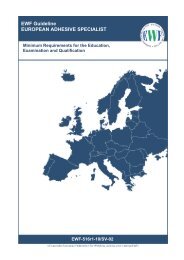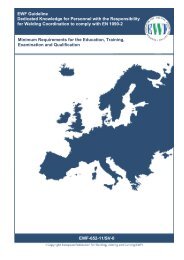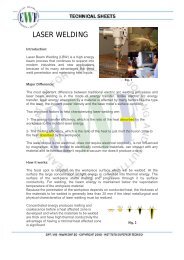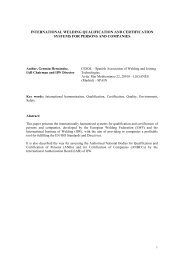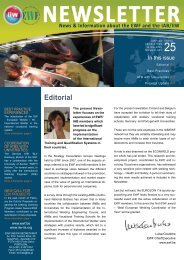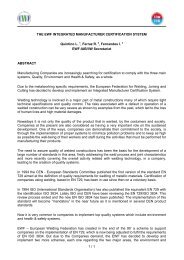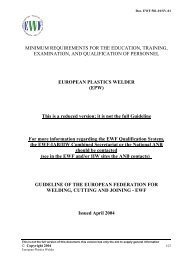Welding Fabrication Standards - EWF
Welding Fabrication Standards - EWF
Welding Fabrication Standards - EWF
Create successful ePaper yourself
Turn your PDF publications into a flip-book with our unique Google optimized e-Paper software.
<strong>Welding</strong> <strong>Fabrication</strong> <strong>Standards</strong> Page 47<br />
As for the approval of welding procedures, qualification by welding procedure test and pre<br />
production test are the only applicable methods, and specific requirements for the acceptance<br />
criteria for the tests are given to integrate the ISO 15614. This is required also in the case of repair<br />
by welding.<br />
In the case of welds other than pressure retaining welds directly attached to the pressure vessels<br />
(e.g. tray rings, support feet, etc.), welding procedure specifications may be acceptable by holding<br />
welding procedure approval records by to previous experience and /or standard welding procedure<br />
for arc welding.<br />
Whenever welders not in the employ of the Manufacturer are used, they shall be under the full<br />
technical control of the Manufacturer and work to the Manufacturer's requirements.<br />
Other requirements are given for filler metals, joint preparation methods, attachment supports and<br />
stiffeners and preheat.<br />
4.5.4 Other requirements<br />
This part of the standards reports other requirements as concerns:<br />
− materials<br />
− manufacturing tolerances;<br />
− production tests;<br />
− forming of pressure parts;<br />
− post weld heat treatment (PWHT);<br />
− repair;<br />
− finishing operations.<br />
4.6 EN 13445 – 5: Inspection and testing<br />
This Part covers all those inspection and testing activities associated with the verification of the<br />
pressure vessel for compliance with the standard, including design review by the Manufacturer and<br />
supporting technical documentation.<br />
Numerous inspection activities, in addition to the Non Destructive Testing (NDT) are described<br />
including document control, material traceability, joint preparation and welding.<br />
The requirements for testing are predominantly related to individually designed single vessels.<br />
However, procedures are provided for serially produced pressure vessels.<br />
The level of testing is driven by the selection of the vessel testing group. Basically, the testing<br />
group determines the level of NDT and the joint coefficient used in the design. There are four<br />
testing groups, which are designed to give the same safety by a combination of several factors.<br />
Istituto Italiano della Saldatura Lungobisagno Istria, 15 - 16141 Genova (I) - Tel. 01083411 - Fax 0108367780



